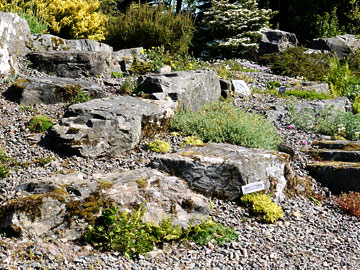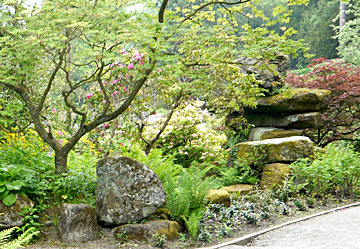Adding plants to the Rock Garden
Decide Your Planting Strategy
It is possible to do the planting as you add each layer of rocks. This may give you a level of satisfaction to see the planting develop alongside the hard landscaping.
However, more care is needed when you are adding rocks to ensure you don't damage the plants you have already put in. In addition, as you add each new layer of rocks you may decide that you need to make changes to the layer beneath. If you are planting during the construction, you may find you need to disturb them again. In most cases you will probably get away with it but you do run the risk of damaging or even killing some plants.
Read Also:
- Siting a Rock Garden
- Materials for a Rock Garden
- Constructing a Rock Garden
- Planting Up a Rock Garden
- Planning a Rock Garden
Planning Your Planting

The best strategy is to complete the hard construction and only then add the plants. This approach has the advantage of more planning opportunities.
If you are so gifted, you may be able to simply look at the finished rock construction and visualise where you want the plants to go to give you pleasing flows of cascading colours or more mundane ground cover.
If you are not so gifted, you may find it useful to photograph the plain structure. You can then print off the photograph and draw in the planting, along with all the colour flows. If your first attempt doesn't produce an acceptable appearance, you can repeat the process as often as necessary until you feel satisfied with the result.
The general aim in planting up the rock garden is that you should only be able to see rocks and plants, with little or no soil visible. Obviously, this is not practical at first planting, but should be the aim when the plants have become established after a year or two of growth. On the other hand, the plants should not be so rampant as to completely cover the rocks. After all, the whole idea of a rock garden is to view it as a pleasing balance between rocks and plants.
Since you are seeking to mimic nature, you do not normally expect to see too much symmetry. In nature, you typically find swathes of one species or colour blending into a neighbouring swathe that is different in appearance. In addition, you will find the occasional specimen plant standing out on its own within the mass plantings.
It is not recommended that you attempt to incorporate every variety of rock garden plant you can find. Decide on a relatively small number of species that you find attractive and which will merge together in a pleasing fashion. It is difficult to be precise about the number of species because circumstances can vary so much, but you are unlikely to need more than half a dozen or so. If in doubt, the best approach is to explore your local area for example rockeries that you find pleasing and take your lead from them.
When selecting your plants, it is very important to study the habits of each one to ensure they will fit into your overall vision for the garden. Look up each species in books or catalogues to establish such features as:

- Colours
- Typical spread and height, trailing or straight growth
- Evergreen or seasonal growth and period of flowering
- Tolerance of sun, shade, moisture or drought
- Weak or strong growth
Bearing these characteristics in mind will also help in deciding how many plants of each species you need to buy.
Some alpine plants are more difficult to cultivate than others. If you wish to grow them you must be prepared to take extra care in how and where you place them and be prepared to care for them in the future. If you want to construct your rock garden and then leave it to mature with the minimum of attention, then you may be well advised to omit the more difficult species.
Unless you are a true expert, you are unlikely to get everything just right at your first attempt. Be prepared to make alterations after the first few seasons, after which you can see how well the plants coexist and deliver the vision you are looking for.
Read Also:
- Siting a Rock Garden
- Materials for a Rock Garden
- Constructing a Rock Garden
- Planting Up a Rock Garden
- Planning a Rock Garden
